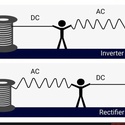Royer Oscillator 100W Load
3
Favorite
0
Copy
692
Views
Circuit Description

Circuit Graph
April 1954 by Richard L. Bright & George H. Royer
This circuit uses a 12V battery with the help of the Royer Oscillator to turn on a 100-Watt light bulb.
You can change the light bulbs setting to 180 watts and it will still work but very dim.
You will see this circuit all over YouTube if you search for "simple inverter", but this circuit is referred to as the Royer Oscillator.
Let's say you have a 12 Volt battery (SLA, Lithium, etc...) and you're trying to turn on an AC load
that is120-240 volts. This is when you would need to use an inverter. An inverter is a circuit that converts
DC to AC. Since not all transistors are made exactly the same in real life, one of these transistors will
activate sooner than the other, and it would make a complete loop through the center tap of the transformer.
When the other transistor activates it would complete the other loop through the center tap of the transformer
creating a change in direction of the current, which is what a transformer needs in order to operate.
It is crucial that one side of your transformer has a center tap pin or else this will not work. You can use a
regular 10:1 step down transformer and use it in reverse 1:10 which is what we are doing here. Most of these household
10:1 transformers have a VA rating of 120 which you can think of as power, so 120 watts. The transistors must be strong
enough to power the load, but if you have a120 watt transformer you can't get more power out of that with stronger transistors.
This is not a good example since were using a light bulb which is a resistive load and doesn't care if the voltage is DC
or AC...it will turn on with both.
It is strongly recommended to use heat sinks as we are getting almost 9 amps in this example on the input side. If you have experience working with this circuit or know of a way to improve upon this circuit, please leave a comment as it can help others.
Open Circuit
✕Circuit Graph
✕







user-943597 says:
TEHRANGELES⚡ says:
Below I have listed a bunch of circuits that oscillate given DC voltage.
Let me know if you have any questions. Thank you for the feedback!
https://www.multisim.com/content/CRBXXqghdCWvniVfrwcCnN/arash-kalhori-oscillator/
https://www.multisim.com/content/N4TQQvnu2xt46xLFitmdnc/arduino-pwm-power-inverter-sine-wave/
https://www.multisim.com/content/XLadTSGFf6JKPhVpnycMkD/mosfet-zvs-royer-oscillator-square-wave-650w/
https://www.multisim.com/content/Rf2xTrMZKkj5cR7cEAe7rs/royer-zvs-sine-wave-12v-to-500v/
https://www.multisim.com/content/24kq5wxzYb3usD6Tp84Wst/power-inverter-60-hz-sine-wave/
https://www.multisim.com/content/DQMD4zFxeSMHtiayxAQvwb/zvs-sine-wave-120v-60hz-no-center-tap/
https://www.multisim.com/content/PawqiFRf6XSxyzyfcFU5kP/zvs-oscillator-sine-wave/
https://www.multisim.com/content/8EFnkaMY5JmhzxNrM2K7cb/zvs-oscillator-test-sine-wave-25khz/
https://www.multisim.com/content/nb6Eo4erhnfmCL3Z7pn8gT/voltage-quadrupler-zvs-sine-wave/
https://www.multisim.com/content/EgxKF2S9L7Ca6vqWLdM83H/arduino-mains-power-inverter-square-wave/
https://www.multisim.com/content/kAUbVHAmNr4xmvwnMfaPVc/zvs-royer-transformer-driver-sine-wave/
https://www.multisim.com/content/7zEpAe9jULnj6Jj4CXqn42/zvs-royer60hz-sine-wave-transformer-driver/